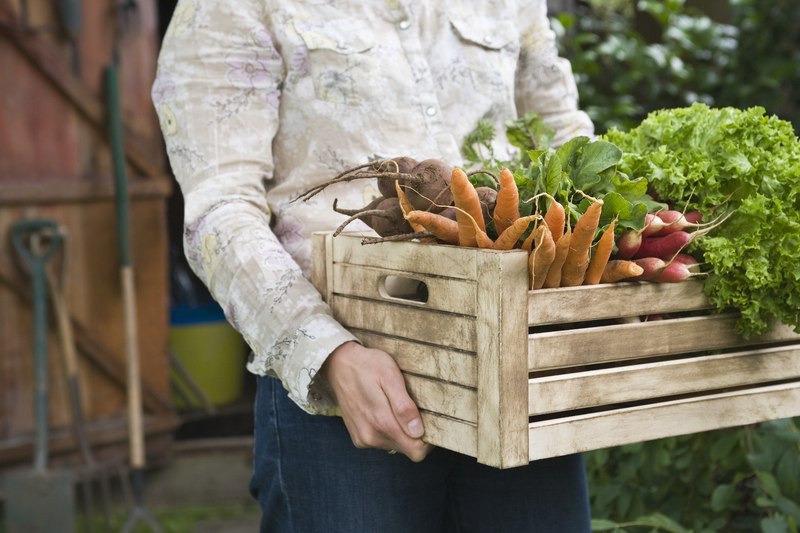Gardening Bliss Awaits: 3 Tips for a Weed-Free Life
Posted on 07/09/2025
Gardening Bliss Awaits: 3 Tips for a Weed-Free Life
Are you dreaming of a lush, vibrant garden without the endless struggle against unwanted weeds? Maintaining a weed-free garden might seem overwhelming, but it is entirely possible with the right approach. A garden unburdened by invasive weeds not only looks stunning but also promotes the health of your precious plants. In this comprehensive guide, you'll discover powerful techniques and proven strategies to achieve gardening bliss and enjoy a weed-free life. Whether you're a seasoned green thumb or a beginner, these three expert tips will transform the way you tackle garden weeds and allow you to savor every moment spent in your backyard sanctuary.
Why a Weed-Free Garden Matters
Weeds are more than just an aesthetic nuisance. They steal vital nutrients, sunlight, and water from your desired plants, often stunting their growth or even causing them to wither. In addition, certain weed species can attract harmful pests or harbor plant diseases, further threatening your landscape. By embracing effective weed control methods, you not only enhance the beauty of your yard but also encourage healthier, more robust growth among your flowers, shrubs, and vegetables. Imagine a garden where every plant flourishes, unencumbered by the relentless competition posed by weeds!

Gardening Bliss Awaits: Essential Mindset for Weed-Free Success
To experience pure gardening bliss and make the vision of a weed-free garden your reality, it's essential to adopt a proactive, consistent approach. Weeds are persistent, but with smart strategies, they won't stand a chance. Let's uncover the three transformative tips that will lead you to a life of richer, healthier, and weed-free gardening.
Tip 1: Start with Smart Design and Preventative Measures
The Power of Prevention: Outwit Weeds Before They Start
The first step to winning the weed-free gardening battle is to make your garden less hospitable to weeds in the first place. Smart garden design and preventative actions serve as your initial line of defense, reducing the need for endless weeding and chemical treatments.
-
Mulch for Maximum Protection:
Mulching is one of the most effective techniques to block weed growth. Organic mulches--such as wood chips, straw, shredded leaves, and compost--act as a barrier, preventing weed seeds from accessing sunlight and sprouting. Inorganic options, like landscaping fabric and gravel, are also popular. As a bonus, mulch helps retain soil moisture and regulate temperature for your desired plants.
Apply a 2-3 inch layer of mulch around plants, leaving space around stems, to inhibit weed emergence without suffocating your flowers or vegetables. -
Densely Plant Garden Beds:
Weeds thrive in empty spaces. By designing your garden beds with densely spaced plantings, you create a "living mulch" that shades the soil and outcompetes weeds for resources. Not only will your beds look fuller and lusher, but you'll drastically reduce weeding chores. -
Use Landscape Fabric Wisely:
For especially troublesome or newly established areas, consider laying landscape fabric beneath your mulch. This dual-layer barrier is a formidable obstacle against perennial and annual weeds, especially when used under pathways or around trees and shrubs.
Top Design Moves to Discourage Weeds
- Create defined borders and edges around garden beds to help stop grass and weeds from creeping in.
- Regularly replenish mulch and organic matter throughout the season to maintain maximum weed suppression.
- Match plant choices to your local climate and soil conditions for vigorous growth that naturally shades out weeds.
Tip 2: Master Manual Weed Removal for Lasting Results
Effective Hand-Weeding Techniques
There's no denying the satisfaction that comes from removing a weed at its root. Hand-weeding is a timeless and eco-friendly way to eliminate existing weeds, particularly in flower beds, vegetable patches, and around delicate plants. Here's how to maximize your efforts:
-
Weed at the Right Time:
For best results, target weeds after a light rain or watering, when the soil is moist and roots are easier to pull out whole. Dry, compacted soil makes weeding more labor-intensive and increases the risk of breaking roots, allowing regrowth. -
Remove Entire Roots:
Many weeds, such as dandelions and bindweed, are notorious for regenerating from small root fragments. Use specialized hand tools--like a dandelion digger, hoe, or weeding fork--to dislodge the complete root system. -
Weed Early and Often:
Don't allow weeds to mature and spread seeds! Check your garden regularly and eliminate pesky intruders while they're still young and easy to manage. A few minutes every week spent on weeding is far more effective than hours spent correcting an overgrown jungle.
Pro-Tip: Harness the Power of Routine
Dedicate a weekly garden walk to spot and remove emerging weeds before they have a chance to take over. This habit reduces workload, protects your plants, and supports a consistently beautiful, weed-free landscape.
Tip 3: Cultivate Healthy, Competitive Plants
Boost Plant Health to Outcompete Weeds
The healthiest, most vigorous plants are often those that have the greatest ability to repel weeds. When your garden is populated by robust, thriving flowers, shrubs, or veggies, weeds have a tougher time finding room or resources to take hold. Here's how to tip the balance in favor of your favorites:
-
Feed Your Soil:
Begin each season by enriching your soil with high-quality compost or organic matter. Healthy, nutrient-rich soil leads to strong plant growth and powerful root systems that naturally crowd out weeds. Test your soil every few years to spot deficiencies. -
Water Wisely:
Direct-planted garden beds should be watered deeply and less frequently, so water can reach roots and encourage plants to establish broadly. Consider drip irrigation systems or soaker hoses for targeted hydration, which discourages weed seeds from germinating in dry, unwatered areas. -
Choose Ground Covers and Perennials:
Incorporate low-growing ground covers--such as creeping thyme, clover, or ajuga--between larger plants. These living carpets not only enhance the look of your garden but also suppress weeds by shading soil and occupying open ground.
The Role of Crop Rotation and Companion Planting
In vegetable gardens, rotating your crops and practicing companion planting can help reduce certain type of weeds and soil-borne diseases. For example, planting legumes after a heavy feeder like tomatoes will both enrich the soil and disrupt weed cycles. Plants like marigolds and nasturtiums can deter pests and fill in gaps to further minimize weed opportunities.
Bonus Tip: Organic and Eco-Friendly Weed Control Options
For gardeners committed to sustainability, organic weed control methods are both effective and environmentally responsible. Here are a few approaches to consider:
-
Boiling Water or Vinegar:
For weeds growing between pavers or in unwanted locations, boiling water or household vinegar can provide a quick, natural kill. Use with caution, as these methods are non-selective and will damage any plant they contact. -
Solarization:
If you're starting a new bed plagued by weeds, covering the soil with clear plastic for several weeks during hot weather can "cook" weed seeds and roots, sterilizing the area for future planting. -
Corn Gluten Meal:
This natural pre-emergent herbicide can prevent certain annual weeds from germinating in lawns or garden beds. Apply early in the season, following package instructions for best results.
Common Weed Types and How to Handle Them
Understanding your enemy is half the battle. Here's a quick overview of common garden weeds and best ways to manage them:
- Dandelion: Deep taproots; pull after rain and remove entire root system.
- Crabgrass: Annual weed; mulch beds, mow lawns high, and overseed to prevent open spaces.
- Bindweed: Persistent perennial; smother with mulch and remove new shoots promptly.
- Nutsedge: Stubborn perennial; maintain healthy, dense turf or beds to crowd it out.
- Clover: Often benign and beneficial, but mulch can reduce excess in ornamental beds.

Maintaining Your Weed-Free Oasis: Ongoing Care Strategy
The path to a weedless garden is paved with consistency and care. Once you've established effective strategies, it's time to maintain your beautiful results:
- Inspect all garden areas regularly for signs of new weed growth.
- Promptly pull or treat any emerging weeds before they mature and spread seeds.
- Annually refresh mulch layers to maintain effective soil coverage and weed suppression.
- Feed and water your chosen plants, so they stay healthy and outcompete any invaders.
- Enjoy the process! A little regular effort results in a far more enjoyable, low-maintenance garden.
The Path to Gardening Bliss Awaits You
By following these top three tips for a weed-free garden--prevention through smart design, diligent manual removal, and cultivating healthy plants--you'll be well on your way to achieving the gardening bliss you've always desired. Remember: consistency is your ally, and every small action adds up to lasting beauty and joy.
Embrace these weed-busting habits, and soon your green spaces will flourish with vitality, color, and tranquility. After all, gardening isn't just about plants; it's about wellness, happiness, and the satisfaction of a garden truly at its best. Enjoy your weed-free gardening life--bliss is just a step away!
Frequently Asked Questions About Weed-Free Gardening
-
What is the best mulch for weed control?
Organic mulches like wood chips, bark, straw, and compost are ideal for suppressing weeds while improving soil health. Inorganic mulches (like gravel or landscape fabric) also work well in certain decorative or permanent settings. -
Can I achieve a weed-free lawn without chemicals?
Yes! Regular mowing, overseeding, proper fertilizing, and spot-weeding help maintain a dense lawn that naturally resists weeds. Corn gluten meal is a good organic "pre-emergent" option in lawns. -
How often should I weed my garden?
A weekly inspection--especially during peak growth seasons--helps you keep weeds at bay and your garden looking its best. -
Is landscape fabric safe for all plants?
Landscape fabric is great beneath pathways, shrubs, and trees, but avoid planting shallow-rooted annuals directly through it, as it may impede their growth.
Ready to experience gardening bliss? Start implementing these strategies today and enjoy a vibrant, healthy, and truly weed-free life in your garden sanctuary!

